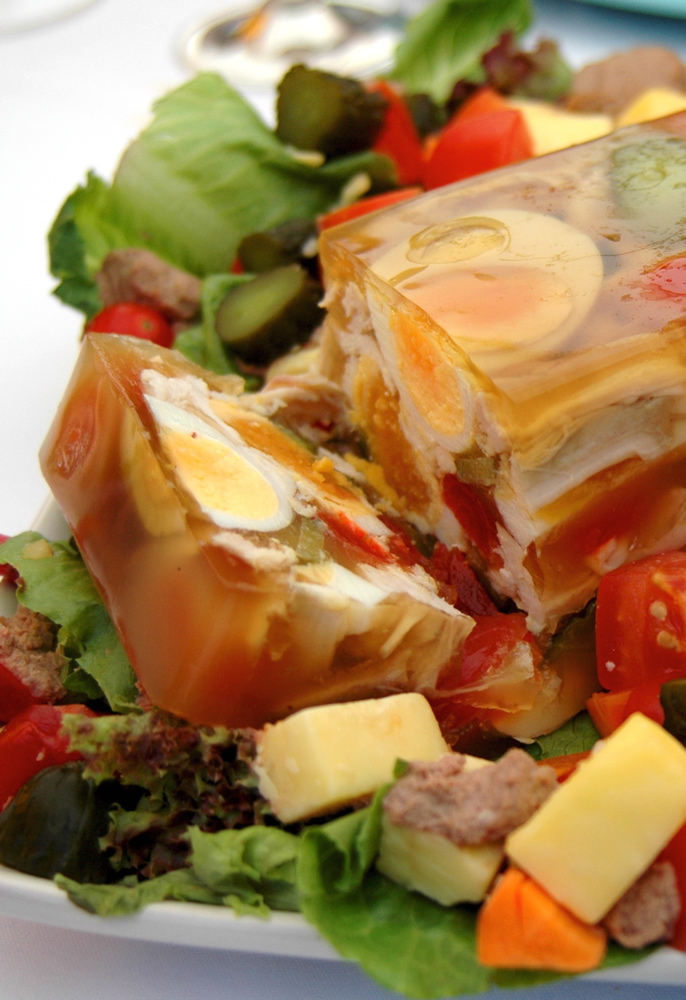|
Pork Pie
A pork pie is a traditional English meat pie, usually served either at room temperature or cold (although often served hot in Yorkshire). It consists of a filling of roughly chopped pork and pork fat, surrounded by a layer of jellied pork stock in a hot water crust pastry. It is normally eaten as a snack or with a salad. History Modern pork pies are a direct descendant of the raised meat pies of medieval cuisine, which used a dense hot water crust pastry as a simple means of preserving the filling. In France the same recipes gave rise to the modern . Many medieval meat pie recipes were sweetened, often with fruit, and were meant to be eaten cold: the crust was discarded rather than being eaten. A particularly elaborate and spectacular recipe described in medieval recipe collection '' The Forme of Cury'' was a meat pie featuring a crust formed into battlements and filled with sweet custards, the entire pie then being served flambeed: a distant descendant of this dish, with hol ... [...More Info...] [...Related Items...] OR: [Wikipedia] [Google] [Baidu] |
Aspic
Aspic () or meat jelly is a savoury gelatin made with a meat stock (food), stock or broth, set in a mold to encase other ingredients. These often include pieces of meat, seafood, vegetable, or eggs. Aspic is also sometimes referred to as ''aspic gelée'' or ''aspic jelly''. In its simplest form, aspic is essentially a gelatinous version of conventional soup. History According to one poetic reference by Ibrahim ibn al-Mahdi, who described a version of a dish prepared with Iraqi carp, it was "like ruby on the platter, set in a pearl ... steeped in saffron thus, like garnet it looks, vibrantly red, shimmering on silver". Historically, meat aspics were made even before fruit- and vegetable-flavoured aspics. By the Middle Ages, cooks had discovered that a thickened meat broth could be made into a jelly. A detailed recipe for aspic is found in ''Le Viandier'', written in or around 1375. In the early 19th century, the French chef Marie-Antoine Carême created chaudfroid. The term ''ch ... [...More Info...] [...Related Items...] OR: [Wikipedia] [Google] [Baidu] |
Pork Loin
Pork loin is a cut of meat from a pig, created from the tissue along the dorsal side of the rib cage. Chops and steaks Pork loin may be cut into individual servings, as chops ( bone-in) or steaks (boneless) which are grilled, baked or fried. Joints or roasts A pork loin joint or pork loin roast is a larger section of the loin which is roasted. It can take two forms: 'bone in', which still has the loin ribs attached, or 'boneless', which is often tied with butchers' string to prevent the roast from falling apart. Pork rind may be added to the fat side of the joint to give a desirable crackling which the loin otherwise lacks. Back bacon Loin can be cut with the side and cured to make back bacon, which is particularly popular in the United Kingdom and Canada. ''Lonzino'' ''Lonzino'' is a type of ''salume'' produced in Italy with cured pork loin. It is distinct from cured pork loin, which is known as ''lonza''. See also * Cuts of pork File:British Pork Cuts.svg, 4 ... [...More Info...] [...Related Items...] OR: [Wikipedia] [Google] [Baidu] |
Bonfire Night
Bonfire Night is a name given to various yearly events marked by bonfires and fireworks. These include Guy Fawkes Night (5 November) in Great Britain; All Hallows' Eve (31 October); May Eve (30 April); Midsummer Eve/Saint John's Eve (23 June); the Eleventh Night (11 July) among Northern Ireland Protestants; and the Feast of the Assumption (15 August) among Northern Ireland Catholics. Significance In Great Britain, Bonfire Night is associated with the tradition of celebrating the failure of Guy Fawkes' actions on 5 November 1605.) The British festival is, therefore, on 5 November, although some commercially driven events are held at a weekend near to the correct date, to maximise attendance. Bonfire night's sectarian significance has generally been lost: it is now usually just a night of revelry with a bonfire and fireworks, although an effigy of Guy Fawkes is burned on the fire. Celebrations are held throughout Great Britain; in some non-Catholic communities in Northern Ir ... [...More Info...] [...Related Items...] OR: [Wikipedia] [Google] [Baidu] |
Christmas
Christmas is an annual festival commemorating Nativity of Jesus, the birth of Jesus Christ, observed primarily on December 25 as a Religion, religious and Culture, cultural celebration among billions of people Observance of Christmas by country, around the world. A liturgical year, liturgical feast central to Christianity, Christmas preparation begins on the Advent Sunday, First Sunday of Advent and it is followed by Christmastide, which historically in the West lasts Twelve Days of Christmas, twelve days and culminates on Twelfth Night (holiday), Twelfth Night. Christmas Day is a public holiday in List of holidays by country, many countries, is observed religiously by a majority of Christians, as well as celebrated culturally by many non-Christians, and forms an integral part of the annual Christmas and holiday season, holiday season. The traditional Christmas narrative recounted in the New Testament, known as the Nativity of Jesus, says that Jesus was born in Bethlehem, in ... [...More Info...] [...Related Items...] OR: [Wikipedia] [Google] [Baidu] |
Protected Designation Of Origin
The protected designation of origin (PDO) is a type of geographical indication of the European Union aimed at preserving the designations of origin of food-related products. The designation was created in 1992 and its main purpose is to designate products that have been produced, processed and developed in a specific geographical area, using the recognized know-how of local producers and ingredients from the region concerned. Features The characteristics of the products protected are essentially linked to their terroir. The European or UK PDO logo, of which the use is compulsory, documents this link. European Regulation 510/2006 of 20 March 2006 acknowledges a priority to establish a community protection system that ensures equal conditions of competition between producers. This European Regulation is intended to guarantee the reputation of regional products, adapt existing national protections to make them comply with the requirements of the World Trade Organization, and info ... [...More Info...] [...Related Items...] OR: [Wikipedia] [Google] [Baidu] |
Melton Mowbray Pork Pie Association
The Melton Mowbray Pork Pie Association is a group of pork pie manufacturers in the Melton Mowbray area of England, United Kingdom. The association was set up in 1998 with the aim of helping to protect the Melton Mowbray pork pie recipe. Product protection under the EU In 1999 the association, a group of seven local manufacturers, applied to the EU to have their products categorised as having Protected Geographical Indication, to ensure that only pies made in an area around Melton Mowbray could use the Melton Mowbray name. Northern Foods, a large food corporation, tried to prevent this move over the usage of "Melton Mowbray" on the wrappings of its own pork pies. Northern Foods viewed the situation as unfair and stated in press releases that the MMPPA's dominant member, Samworth Brothers, has made cured and uncured pork pies in Leicester and that the designation area was shaped to include the Samworth factory there. According to Northern Foods, 99% of the pork pies made under th ... [...More Info...] [...Related Items...] OR: [Wikipedia] [Google] [Baidu] |
Fox Hunting
Fox hunting is an activity involving the tracking, chase and, if caught, the killing of a fox, normally a red fox, by trained foxhounds or other scent hounds. A group of unarmed followers, led by a "master of foxhounds" (or "master of hounds"), follow the hounds on foot or on horseback. Fox hunting with hounds, as a formalised activity, originated in England in the sixteenth century, in a form very similar to that practised until February 2005, when a law banning the activity in England and Wales came into force. A ban on hunting in Scotland had been passed in 2002, but it continues to be within the law in Northern Ireland and several other jurisdictions, including Australia, Canada, France, Republic of Ireland, Ireland and the United States. The sport is controversial, particularly in the United Kingdom. Proponents of fox hunting view it as an important part of rural culture and useful for reasons of Conservation movement, conservation and pest control, while opponents argue ... [...More Info...] [...Related Items...] OR: [Wikipedia] [Google] [Baidu] |
Leicestershire
Leicestershire ( ) is a Ceremonial counties of England, ceremonial county in the East Midlands of England. It is bordered by Derbyshire, Nottinghamshire and Lincolnshire to the north, Rutland to the east, Northamptonshire to the south-east, Warwickshire to the south-west, and Staffordshire to the west. The city of Leicester is the largest settlement and the county town. The county has an area of and a population of one million according to 2022 estimates. Leicester is in the centre of the county and is by far the largest settlement, with a Leicester urban area, built-up area population of approximately half a million. The remainder of the county is largely rural, and the next-largest settlements are Loughborough in the north, Hinckley in the south-west, and Wigston south-east of Leicester. For Local government in England, local government purposes Leicestershire comprises a non-metropolitan county, with seven districts, and the Unitary authorities of England, unitary authority a ... [...More Info...] [...Related Items...] OR: [Wikipedia] [Google] [Baidu] |
Melton Mowbray
Melton Mowbray () is a market town in the Borough of Melton, Melton district in Leicestershire, England, north-east of Leicester and south-east of Nottingham. It lies on the River Eye, Leicestershire, River Eye, known below Melton as the River Wreake, Wreake. The town had a population of 27,670 in 2019. The town is sometimes promoted as Britain's "Rural Capital of Food"; it is the home of the Melton Mowbray pork pie and is the location of one of six licensed makers of Stilton cheese. History Toponymy The name comes from the early English word ''Medeltone'' – meaning 'Middletown surrounded by small hamlets' (as do Milton and Middleton). House of Mowbray, Mowbray is the Normans, Norman family name of early Lord of the Manor, Lords of the Manor – namely Robert de Mowbray. Early history In and around Melton, there are 28 scheduled ancient monuments, some 705 buildings of special architectural or historical interest, 16 sites of special scientific interest, and several deserte ... [...More Info...] [...Related Items...] OR: [Wikipedia] [Google] [Baidu] |
Large Pork Pie Cut In Half On A Cutting Bord Made Of Wood
Large means of great size. Large may also refer to: Mathematics * Arbitrarily large, a phrase in mathematics * Large cardinal, a property of certain transfinite numbers * Large category, a category with a proper class of objects and morphisms (or both) * Large diffeomorphism, a diffeomorphism that cannot be continuously connected to the identity diffeomorphism in mathematics and physics * Large numbers, numbers significantly larger than those ordinarily used in everyday life * Large ordinal, a type of number in set theory * Large sieve, a method of analytic number theory ** Larger sieve, a heightening of the large sieve * Law of large numbers, a result in probability theory * Sufficiently large, a phrase in mathematics Other uses * ''Large'' (film), a 2001 comedy film * Large (surname), an English surname * LARGE, an enzyme * Large, a British English name for the maxima (music), a note length in mensural notation * Large, or G's, or grand, slang for $1,000 US dollars * Large, ... [...More Info...] [...Related Items...] OR: [Wikipedia] [Google] [Baidu] |
Melton Mowbray Pork Pie
A pork pie is a traditional English meat pie, usually served either at room temperature or cold (although often served hot in Yorkshire). It consists of a filling of roughly chopped pork and pork fat, surrounded by a layer of jellied pork stock in a hot water crust pastry. It is normally eaten as a snack or with a salad. History Modern pork pies are a direct descendant of the raised meat pies of medieval cuisine, which used a dense hot water crust pastry as a simple means of preserving the filling. In France the same recipes gave rise to the modern . Many medieval meat pie recipes were sweetened, often with fruit, and were meant to be eaten cold: the crust was discarded rather than being eaten. A particularly elaborate and spectacular recipe described in medieval recipe collection ''The Forme of Cury'' was a meat pie featuring a crust formed into battlements and filled with sweet custards, the entire pie then being served flambeed: a distant descendant of this dish, with hollo ... [...More Info...] [...Related Items...] OR: [Wikipedia] [Google] [Baidu] |
Gelatin
Gelatin or gelatine () is a translucent, colorless, flavorless food ingredient, commonly derived from collagen taken from animal body parts. It is brittle when dry and rubbery when moist. It may also be referred to as hydrolyzed collagen, collagen hydrolysate, gelatine hydrolysate, hydrolyzed gelatine, and collagen peptides after it has undergone hydrolysis. It is commonly used as a gelling agent in food, beverages, medications, drug or vitamin capsules, photographic films, papers, and cosmetics. Substances containing gelatin or functioning in a similar way are called gelatinous substances. Gelatin is an irreversibly hydrolyzed form of collagen, wherein the hydrolysis reduces protein fibrils into smaller peptides; depending on the physical and chemical methods of denaturation, the molecular weight of the peptides falls within a broad range. Gelatin is present in gelatin desserts, most gummy candy and marshmallows, ice creams, dips, and yogurts. Gelatin for cooking comes ... [...More Info...] [...Related Items...] OR: [Wikipedia] [Google] [Baidu] |







